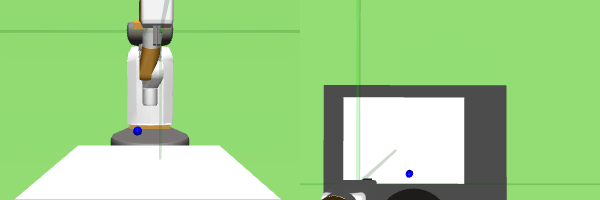Image based OpenAI Gym environment
This is a custom Gym environment FetchReach-v1 implementation following this tutorial. Out of box FetchReach-v1 observation is robot pose rather than pixels, so this is my attempt to change that. Currently I have added two cameras.
Installation
Install custom Gym environment:
pip install gymgit clone https://github.com/Naurislv/image_based_fetch_gym_env.gitcd image_based_fetch_gym_envpip install -e .
Usage
Run run_example.py. It will save 20 observation frames in local ./frames/.. directory.
Spaces
env.observation_space['observation']: Box(RGB uint8 array consisting of 2 images stiched together. These are two different camera views in environment.)env.observation_space['desired_goal']: Box(x, y, z coordinates of desired goal)env.observation_space['achieved_goal']: Box(x, y, z coordinates of achieved goal)env.action_space: Box(actions)
My Approach
From here I copied and adjusted following files:
- Environment:
fetch_env.py - Assets (MuJoCo) description:
reach.xml,robot.xmlandshared.xml - Stls and textures for fetch environment
Motivation
I am working on sophisticated robotics solutions for Smart Manufacturing use-cases. In my experience simpler solutions often work better in production than more complex, think OpenCV vs Machine Learning. Supervised Machine Learning methods are very hard to implement in the factory because you almost never have enough nor right data to feed for algorithms. While solutions implementing classical Computer Vision algorithms (OpenCV) work well in many cases, they introduce other challenges such as calibration requirements, longer robot setups, more complex development, engineering pipelines, etc.
When looked through the vast resources and possibilities to set up the simulator for Robotics use-cases I stumbled upon a few major obstacles:
- I am not planning to create an environment from scratch therefor most environments did not fit the bill just because they are way off from what I want.
- Most environments are not suitable for Reinforcement learning because it's hard or impossible to speed them up.
- Even if the environment supports speed up the interface is complicated to use and integrating Reinforcement learning algorithms are rather uneasy.
So I settled on OpenAI Gym which seems to bring the best balance. Once I'll need something which will reflect the real world in more detail, I will revisit this topic.
